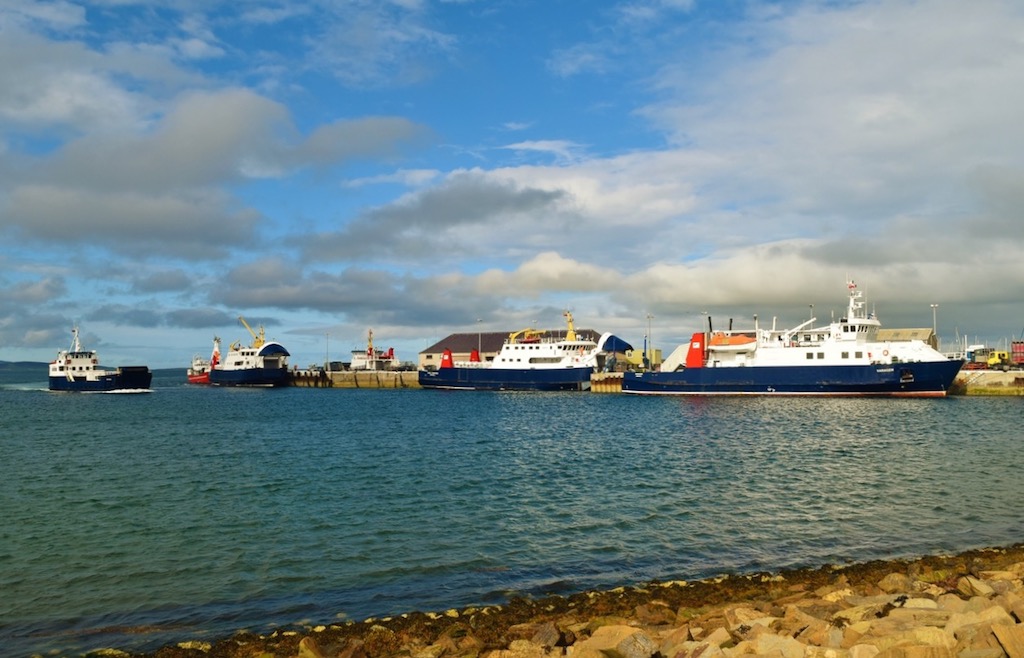
Kirkwall, 30 August 2019: (left to right) Shapinsay, Earl Sigurd, Thorsvoe (on far side of quay), Earl Thorfinn and Varagen — photo © Mark Nicolson
A year after his first visit to Orkney, Mark Nicolson returned there in the hope of sailing on some of the ships he had missed first time round. Having given advance notice of his 25th birthday, he received a hearty welcome.
Eager to follow up my adventures in Orkney last year, I found myself heading that way again this summer, on a trip coinciding with my 25th birthday. After completing grand tours earlier in the summer of the Clyde network and out of Oban, I was hoping for a hat trick of successful holidays. The aim was to attempt more sailings than I had done in 2018.
Loch Seaforth from Stornoway to Ullapool – 28 August
Although not part of the Northern Isles, I still had to reach the mainland by way of Loch Seaforth’s 0700 sailing from Stornoway to Ullapool. Despite this ship’s poor internal layout and her controversial stern paint work, I still regard her as an impressive sea keeping vessel and with great looks for the modern age. For me, a voyage on this ship is never the same without a bridge visit to see Captain John Gillies, her last remaining master from her introduction nearly five years ago. Of the other two, Lewis Mackenzie is now an all-round relief master, whilst Byron Griffiths has moved to Lord of the Isles.
Meeting Captain Gillies again made for a great start to the day. After reaching Ullapool at 0930, I started out on the long drive to Scrabster harbour, via Inverness for lunch and shopping.
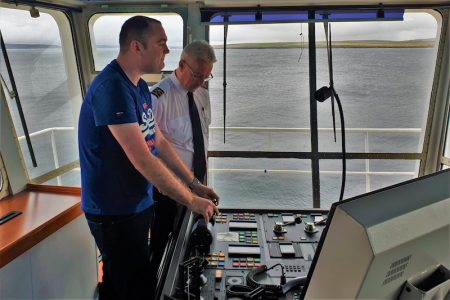
Mark Nicolson at the control console of Hamnavoe at Scrabster
Hamnavoe from Scrabster to Stromness – 28 August
For many visitors to Orkney, the port of Scrabster outside Thurso marks the real starting point, allowing a chance to relax following the drive along the A9 road north from Inverness. I watched the swift arrival of Hamnavoe into the harbour, where the ship always looks initially to have overshot the pier, but then reverses almost dead straight towards her berth at the new terminal, purpose-built for her. The original linkspan once used by the former P&O vessels has now been removed.
Although I had high hopes of visiting the bridge on this voyage, I did not anticipate the surprises the crew had in store for my birthday sailing. Captain Chris Tait and his crew had organised a doughnut-shaped caramel cake for me. Even better, under the master’s guidance I was shown how to take Hamnavoe out to sea. It made me appreciate how much of a team effort guiding such a vessel is.
After this excitement, I was allowed to remain on the bridge as Hamnavoe tackled the north-westerly swells she has become so used to in the 16 years she has been in service. A spectacular sunset broke through the clouds as we passed the Old Man of Hoy.
Pentalina round trip from St Margaret’s Hope to Gill’s Bay – 29 August
Orkney can be reached not just by way of Scrabster to Stromness, but also on Pentland Ferries’ catamaran Pentalina, purpose built for Andrew Banks’ family-run firm in 2009, and soon to be replaced by the new Vietnamese-built Alfred. Andrew formed the company in 1997, and from May 2001 used former CalMac vessels, Pentalina B ex Iona and Claymore. Since their sale, Pentalina has operated the service singlehanded. The former CalMac ‘streaker’ Saturn (renamed Orcadia) has lain high on a sandback at St Margaret’s Hope since her purchase in 2015. It seems unlikely she will see service again.

Pentalina, pictured at St Margaret’s Hope on 29 August 2019, offers a good service but her shabby waterline does not go unnoticed
A 50% discount is offered to any foot passengers wishing to undertake an immediate return voyage from the Orkney side of the route. And so I boarded Pentalina with a sense of excitement for her 1130/1330 return to Gill’s Bay, which she is able to do each way in an hour.
She was slightly delayed owing to some last minute shows that only just managed to squeeze onto the ship’s packed car deck. The initial departure takes up to three turns to port in order to head in a west-southwesterly direction, passing the small village of Hoxa to port, with the oil terminal on the island of Flotta to starboard.
Even though there was a moderate westerly swell, Pentalina’s twin hulled design allowed for a smooth passage, revealing a more hydrodynamic design approach than traditional monohull vessels. She has the same speed as Isle of Lewis — 18 knots.
We passed two more islands — Swona and Stroma, both totally abandoned — before the final approach towards Gill’s Bay. Soon enough Pentalina was brought alongside, and I was required to disembark to collect my boarding card for the return journey to Orkney, allowing time for photographs of the vessel alongside the pier as the sun began to peek through once again.
Internally, there is not much to describe. Both sides of the vessel have reclining seating areas, whilst a snack bar offering hot filled rolls is sufficient for a journey lasting an hour. In my case, there was a beef burger for the outward journey, with a roll and sausage on the way back.
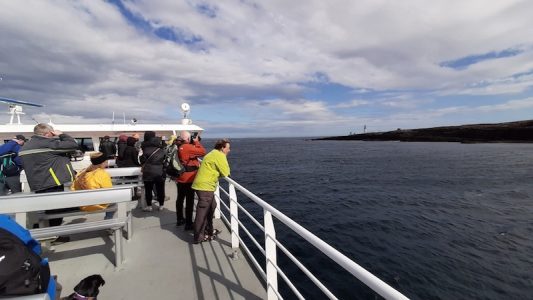
Top deck panorama on Pentalina, passing Stroma Lighthouse
The open deck is unique in the sense that passengers are able to get a great view of the bridge without restricting the captain and officers’ visibility.
Although Pentalina’s car deck is spacious enough, she suffers from not being a drive-through vessel: vehicles mostly board and turn towards the stern, the only end of the vessel that can load. It is unlikely stern-loading catamarans like this would work on the Clyde and Hebridean network.
An uneventful return journey did see one moment where a fast moving tide pushed Pentalina’s speed over 21 knots, followed by a sharp turn to port to keep on course for Orkney as we approached a big wave. This resulted in a multitude of motions for a few seconds, although there was no dramatic shuddering to make travellers feel too uneasy.
While maintenance levels leave a lot to be desired on Pentalina, the service she offers shows what could be done to improve the situation on the west coast, where routes such as Oban-Craignure and Ardrossan-Brodick could benefit from catamaran operation. Terminals would most likely have to be modified to allow drive-through variations of these designs to work efficiently. As they say, where there is a will, there is a way.
Eynhallow from Tingwall to Rousay, Egilsay & Wyre – 29 August
The next sailing I undertook was from the small jetty of Tingwall, where I was to await the arrival of the Abels of Bristol-built Eynhallow. At first glance, this vessel looks to be an upgraded version of the ‘Island’ class ferries, built for CalMac in the 1970s and now no longer with the company. Eynhallow is responsible for serving the smaller islands of Orkney — Rousay, Egilsay and Wyre — and I chose the 1605 departure from Tingwall, which would see me visit all three, including a quick landing at each port for the obligatory photograph.
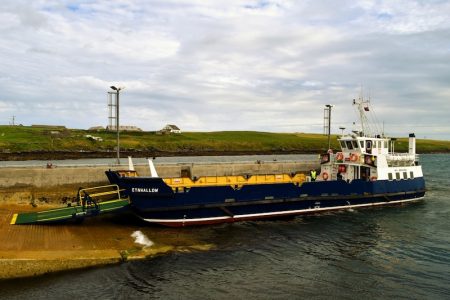
Eynhallow at Egilsay on 29 August 2019
The ship is suitably named given she crosses the Eynhallow Sound. She has a small lounge aft of the car deck. Tall cube-shaped funnels sit at the rear open deck of the ship, where you are inches away from the wash. On departure from Tingwall the ship was quite busy with schoolchildren returning home from Kirkwall.
Among the distinctive features of these islands are the historic buildings. For example, Rousay is home to the magnificent Trumland House, designed by Edinburgh architect David Bryce, who also designed the equally impressive Balfour Castle on Shapinsay. On the farmland-covered Egilsay can be found St Magnus Church, one of two surviving Norse churches in Orkney (the other is St Magnus Cathedral in Kirkwall), whilst Wyre features the ruins of Cubbie Roo’s Castle and St Mary’s Chapel.
It seemed to me that vessels in the style of Eynhallow could prove useful on many of the small west coast routes, due to their ability to land practically anywhere. The ramps are designed to push the bow of the vessel upwards from the ground to avoid getting stuck on land, with a smooth, flat curve in the keel helped by a shallow draught, allowing them to float again without difficulty.
I also found Eynhallow to be very efficient at turning away from each slipway. Her design, based on landing craft from the Second World War, is clearly no less useful today.
Earl Sigurd from Kirkwall to Westray & Papa Westray – 30 August
The final sailing worthy of mention (and I have possibly saved the best until last) was a trip aboard one of the three flagships of the Orkney Ferries fleet, Earl Sigurd. Together with Earl Thorfinn (her sister ship) and Varagen, she operates a roster connecting Kirkwall with the seven northern islands of Orkney — Westray, Papa Westray, Stronsay, Eday, Sanday and North Ronaldsay.
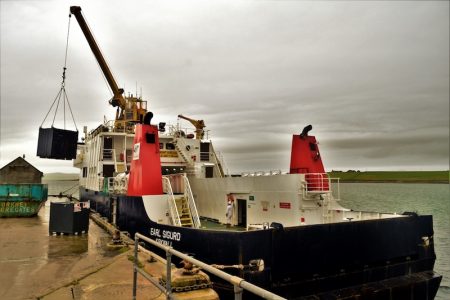
‘Watching cargo being hoisted between ship and pier by crane and sling made me feel I had entered a time machine, transporting me back several decades to witness a procedure now seldom used in more familiar surroundings on the west coast’: Earl Sigurd unloading at Papa Westray, Orkney, on 30 August 2019
It was a rather dreich embarkation at 1045 for Earl Sigurd’s round trip to Rapness on Westray and Papa Westray. With the weather being rather wet, I had time to explore the vessel and her accommodation. Earl Sigurd, the older of the sister ships, was built at McTay’s of Bromborough in 1989, Earl Thorfinn following a year later. From the car deck you climb up two levels to reach the main passenger lounge, and there is some sheltered open deck at the same level on each side. Unusually, both vessels have their cafeterias below the car deck, with the engine room directly behind it. This lower lounge possesses a small snack bar offering a variety of sandwiches and drinks. Further open decks are found aft of the superstructure, where the twin funnels of each vessel are found.
After passing islands such as Egilsay and Eday, we arrived at Rapness terminal on Westray at 1210. The pier uses a linkspan allowing simple ro-ro operation. It was during the next stop at Papa Westray, reached at 1300, where the uniqueness of both ‘Earls’ was well displayed. The pier there has no linkspan at all, so all cargo has to be lifted on and off the ship using a special crane located on the ship’s ‘monkey island’. Having stepped ashore for another photograph, I had to wait for the cargo transfer operations to be completed before I went back on board, so as not to be struck by the errant sling. Witnessing this procedure would make one reminisce about the days of the original Loch Seaforth using a crane to lift cargo on and off during her days on the Stornoway-Kyle-Mallaig mail service. Papa Westray’s lack of a linkspan is a distinction it shares with North Ronaldsay, all the other islands possessing the more modern method of transferring cargo.
There would be no call at Rapness on the return voyage, so it was a direct 1 hour 50 minute trip back to Kirkwall. After some time below (while I sorted through photographs on my laptop), the sun began to emerge, meaning the remainder of the voyage was spent out on deck. I could also see the crew carrying out some much-needed TLC on the ‘Sigurd’: these vessels are true workhorses. Arriving arrived back at Kirkwall at 1520, we found Earl Thorfinn and Varagen waiting to take their next scheduled sailings north, whilst Thorsvoe lay at her berth in advance of a spell of emergency/relief work. Finally, with Shapinsay approaching her berth, I captured a shot of all five vessels in one shot, with sunshine gracing the image. What had started off as a dull departure ended in a bright and triumphant return.
Conclusion
My aim on this latest visit to Orkney was to sail on vessels I had not previously boarded on previous trips there in 2017 and 2018 — and also to make something special of my 25th birthday. These new ventures made me appreciate how much the islanders beyond mainland Orkney rely on council-operated services. Watching cargo being hoisted between ship and pier by crane and sling made me feel I had entered a time machine, transporting me back several decades to witness a procedure now seldom used in more familiar surroundings on the west coast.
These holiday adventures made me appreciate one more thing — the effort and skill of the masters and crews of the North isles ships. They all deserve a closing word to describe them – respect.
All photographs on this page are © Mark Nicolson.
Read Mark’s 2018 Orkney Diary here

Birthday smiles: Mark Nicolson (right) with Captain Chris Tait on the bridge of Hamnavoe
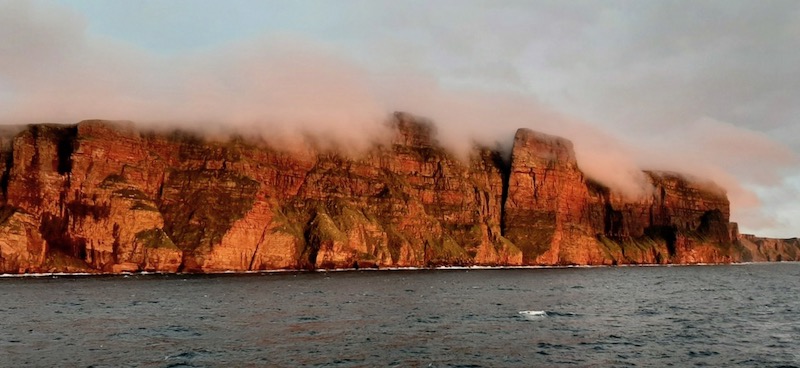
The cliffs of Hoy, viewed from Hamnavoe on 28 August 2019

Hamnavoe at Stromness on 30 August 2019

Scene at Kirkwall: cruise ship MSC Orchestra on 29 August 2019

‘A design based on landing craft from the Second World War’: Eynhallow’s empty car deck on 29 August 2019
Have you joined CRSC? You can do so here for just £10 and get all the benefits.
Published on 9 October 2019











